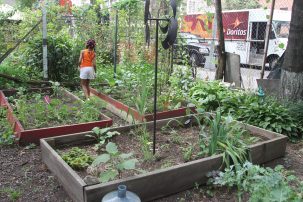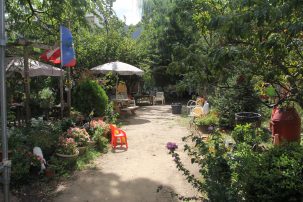News
NEW STUDY: In East Harlem, Community Gardens Provide More Than Food
SHCN faculty researcher Ben Orlove, of Columbia University, is a co-author of a new study of 35 community gardens in East Harlem considering questions of motivation and social value. Read the post below to learn more.
The following post is excerpted and condensed from a larger piece written by Phebe Pierson originally published on State of the Planet, a blog of the Earth Institute at Columbia University. Access the full post here.
The original study was published in the journal, Landscape and Urban Planning. Access the full article here.
—
“En un jardín crecen más cosas que las que siembra el jardinero.”
“In a garden more things grow than what the gardener sows.”
Community gardens have long been a part of New York City’s alternative spaces. But many of us may take the gardens for granted, unaware of their rich history and of the vast benefits they bring to our communities and the city as a whole. Walking by a community garden in your neighborhood and peeking through the gate, you may recognize it as a green space but not understand it as an anchoring presence in your community.
Researchers at the Earth Institute recently published a paper that investigates the environmental and social dimensions of community gardens in East Harlem. The study was conducted by Nada Petrovic, Troy Simpson, and Ben Orlove, all from the Center for Research on Environmental Decisions (CRED) at Columbia University, and Brian Dowd-Uribe of the University of San Francisco. Orlove, who is one of the directors of CRED, says the group wanted to study “what motivates people to engage in green infrastructure—to use it, support it, or maintain it.”
Community gardens help to combat the heat island effect of the city, and they absorb water during weather events to lessen flooding in a city filled with impervious pavement. Simpson says the gardens are also “fascinating physical symbols of people creating value and different forms of community in the areas where they live. [This study] was an opportunity to understand how people relate to the built environment and how it’s changing all the time.”
The study
The researchers investigated the “basic characteristics” of 35 gardens in East Harlem, and the extent to which these characteristics correlated with the gardeners’ feelings about the gardens, particularly their attachment to them. During the summer of 2012, the researchers visited each of the 35 gardens, mapping them and inventorying things like trees, open space, garden beds, seating options, and structures like casitas or gazebos. Simpson recalls “riding bikes around East Harlem and getting to know the gardeners and getting a sense of the whole neighborhood.” The inventories took time— about 1.5 hours each—and sometimes required multiple visits, so the researchers got to know the gardens and communities well.
To collect social data for the study, the team interviewed gardeners in 16 of the gardens, with up to four gardeners interviewed per interview garden. During the interviews, the team assessed members’ feelings about their gardens. They investigated the relationship between place attachment—or the positive emotional bond that develops between individuals and their environment—and the various attributes of the gardens.

The findings
In the paper, the team writes that “It is immediately clear from the interview data that the gardens are deeply significant spaces to their members.” The vast majority of gardeners agreed with statements such as, “I am satisfied with the garden,” and “The garden means a lot to me.” Gardeners also indicated that their gardens increase their pride in the neighborhood and make them less likely to move away.
However, almost half of the gardeners reported feeling insecure about the future of their gardens; the researchers noted that this perspective was especially noticeable among members of gardens managed by HPD that could be developed by the city at some point. Annel Cabrera-Marus of NYRP says that with the addition of the 2ndAvenue subway line, there’s a “pending sensation that there are more things coming” to the neighborhood.
The researchers also investigated gardeners’ motivations for participating in their gardens. While they learned that growing food is one of the primary motivations, most gardeners grow only enough food for a few meals a week. The yield appears not to matter, though; the researchers write that, “many garden members indicated that growing food gives them a sense of ownership, connection, and responsibility to the garden,” regardless of the size of their harvests.
The researchers also found that community gardens play a central role in the social lives of their members. Most gardeners that were interviewed had attended at least one event held at the garden in the last month, and during field visits the researchers encountered or were told about barbecues, birthday parties, permaculture classes, dominoes games, and markets. As such, gardeners reported that they know their neighbors better because of their gardens and that they socialize with people they may not see otherwise.

What does it mean?
One of the takeaways of the study is that growing produce is very important to the gardeners—but the quantity of produce is not. Kenneth Williams, GreenThumb outreach coordinator in East Harlem, says this aligns with his experiences. “When we pursue growing food, what we physically produce is a [by]product of the overall outcome we seek to achieve: healthier lives, self-reliance, autonomy, etc. By the time we accomplish growing that food and reflect on that process, we discover the various milestones we had, not only with what we physically grew, but also within ourselves.”
Cabrera-Marus notes that food is strongly tied to people’s sense of home and belonging. In immigrant communities, gardens can provide a space to put literal roots down and grow plants and herbs from a gardener’s country of origin; Cabrera-Marus points out the popularity of the herb papalo in gardens with Mexican gardeners by way of example. “People often lose sight of what food means to new Americans. We all come from cultures that grow food, and the herbs can connect you back to that,” she says. One of the gardeners interviewed in the study commented that, “I never thought it was possible to have a piece of land in the middle of the city. It reminds me of my home in rural Puebla, Mexico.”
Orlove notes that “The environmental benefits that matter to many planners and policy makers are different from the social benefits that matter most to the gardeners.” Community gardens are important to the health of the whole city, and yet the benefits come out of the labor and love of relatively few dedicated members.
These findings could inform the development of more, stronger community gardens, and possibly other green spaces, in the future. The researchers point out that policies made supporting community gardens focus almost exclusively on promoting health and environmental benefits because those are easy to quantify. Of course those benefits are valuable, but policies of that type are more likely to succeed if they take into consideration what is important to community gardeners, such as healthy community ties, land security, and agency over decision-making.
Access the full story here.




